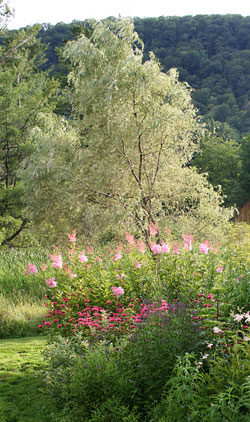 This is the first time that I’ve had this pink Filipendula flower. It’s been in the ground a couple of years from some pots leftover from a local plant sale. (The deer have nipped off the tops before flowering in previous years.)
This is the first time that I’ve had this pink Filipendula flower. It’s been in the ground a couple of years from some pots leftover from a local plant sale. (The deer have nipped off the tops before flowering in previous years.)
It goes close to 6 feet tall. So I’m guessing that it’s Filipendula rubra ‘Venusta’, but there are others that fit this description.
It’s in ‘the wet garden’ along with monarda, eupatorium, veronicastrum, Verbena hastata, Â tradescantia and others that appreciate the constant and sometimes excessive moisture.
There has been a lot of discussion about PhotoShopping images on several other blogs. I did fiddle with these a little. But I was amazed with the differences in bloom color in these evening shots depending on the angles — backlit vs. sun over my shoulder vs. shooting perpendicular to the light. Â The differences in my raw images were even greater than I’d ever see when fiddling around with the images in PhotoShop.
More pix …




That’s beautiful, especially as seen in the wide shot. What’s that gorgeous, silvery tree in the background?
That is a real show stopper… a show-off. Is there a fragrance?
Pam: It’s a willow.
Hank: I wish I could tell you it smells like cotton candy. But it has no aroma that I can detect, though I don’t have the most sensitive nose.
I had a post on Filipendula the other day. It is a great plant for wet areas.
I love your pictures PS’ed or not. I usually run all my photos through Photoshop for minor adjustments. I call it my ‘Digital Darkroom’.
Very, very pretty indeed-my favourite color, pink! The light on it is lovely
I love the Filipendula and while it might prefer a wet area, mine does pretty well sitting high and dry although it is augmented with quite a bit of compost. Just a note in case someone wants to give it a try. It does have a fragrance. Sweet! Great photos!
You sure do handle those tall garden beauties well, Craig. I don’t even like pink all that much in general but I have to say that area is gorgeous with the filipendula, monarda and the silvery willow.
(All I keep “hearing” in my head right now is the Renegade Gardener decreeing: “Give me filipendula!”)
I don’t like pink much, either. But I’ve got a lot of it midsummer.
How nice to stop by and find something that is totally new to me. I’ll have to look into it, but I have a feeling it’s not meant for my zone – plus, I don’t have a very wet area (especially this season). It’s quite beautiful.
Regarding photoshop. I read some of those posts and don’t know how I feel. It’s possible that I don’t care either way – a good image is a good image. I recently downloaded the full version on my home computer for a work-related project – so hadn’t used it until two weeks ago – and I must say I just find it fun. I haven’t even come close to learning everything it can do – but go to the ‘liquify’ function and make your flower petals swirl and sway – it’s just fun. There’s a SC guy, http://www.macroartinnature.com (I think that’s the address) who does incredible macro images – and then describes how he takes the image and then a bit about post-processing. The Blue Ridge Blog person – Maria I think – does the same. I love the work of both of them. I’ve basically been enjoying grayscale and contrast capabilities – but I have a feeling that I could become addicted to the capabilities that it offer. Only problem: my camera is screwing up. Might be time to send it off to Nikon. Ugh.
Pam: The best thing for improving images for me is the Adjust > Levels histogram. Depending on the image, I usually push the outside sliders toward the center a little, then fiddle with the midtones slider. (Don’t ask me what all that means. I just do it.) For pure fun, I like to fiddle with the artistic filters.
Your shots are exquisite of this praire beauty. I’ve had this plant for about 7 years now and have just divided them to share. Like most perennials they do multiply, however, they’re not invasive. They can be grown in zones A1-3, 1-9, 14-17 you will find them reliably hearty.